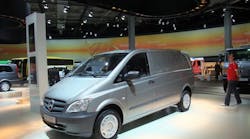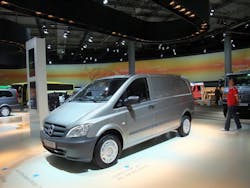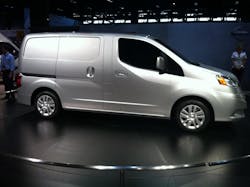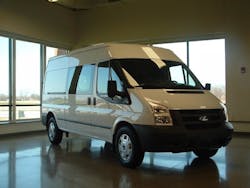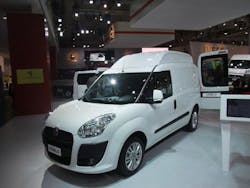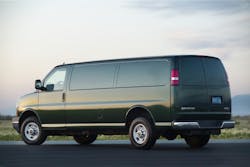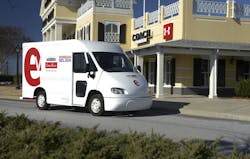Fitted with racks, shelves, extended roofs, hydraulic buckets, or any other useful accessory inventive minds can devise, the commercial van has become an essential tool for a broad range of service fleets. But while other trucks have changed dramatically in the push for ever increasing productivity, the “breadbox” has gone about its business with its basic design and silhouette unchanged for decades.
Now after all those years of small, evolutionary changes, the commercial van is being completely overhauled. If your fleet depends on vans, get ready for a flood of new configurations, powertrains and even sizes. The days of the one-size-fits-all van are over.
The start of the transformation can be traced back to 2001 when Freightliner introduced the Sprinter, a large van from its parent Daimler popular among European fleets. It featured stand-up interior room without any aftermarket modification, a fuel-efficient small diesel engine and design elements specifically aimed at accommodating commercial applications.
A second generation Sprinter, which for some time was also sold by Dodge as part of the former Daimler-Chrysler partnership and is now sold by Mercedes-Benz USA as well as Freightliner, built on those initial strengths, adding active safety systems, more driver comfort features and other options. Though perceived as a premium vehicle, it has shown that a growing number of American users see the value in the European style of dedicated full-size commercial vans. While traditional American-style full-size vans still accounted for over 80% of sales last year, Sprinter doubled its 2010 sales, according to data from WardsAuto.com.
The second part of the van's transformation is coming in what is essentially an entirely new size of dedicated commercial vans for the North American market. While full-size vans are rated around 10,000 lbs. GVW, Ford believed it saw an opening for a smaller commercial truck under 6,000 lbs. GVW. So in 2010, Ford modified its European Transit Connect by swapping out a small diesel for a fuel-efficient 4-cyl. gasoline engine that met U.S. emissions requirements and tested its thesis.
The results even surprised Ford, according to Tim Stoehr, the company's commercial truck marketing manager. Drawn by the large interior cargo capacity in a small package and good fuel economy combined with a true commercial vehicle chassis, North American users bought over 30,000 Transit Connects last year. Those numbers attracted a lot of attention, and suddenly a new category — the Class 1 commercial van — has come to America.
With North American fleets clearly interested in these new types of commercial vans, truck builders have reacted quickly. This year and next will see an unprecedented number of new vehicles introduced both in full-size and Class 1 sizes. And while the traditional American van will be with us for the immediate future, Ford has already announced that the most popular — its E-Series — will be phased out in favor of a new Euro-style vehicle. General Motors, the only other maker of the traditional breadbox van, hasn't been willing to go that far in its public comments, but it has pointedly said that it, too, has a full range of European-style vans in its global portfolio.
Information about these new trucks has been dribbling out over the past few months, butFleet Owner has talked to all of the major players for a comprehensive, first-hand report on the changes coming to vans over the next two years. What follows is a brand-by-brand rundown on the trucks that will completely remake the commercial van fleet.
MBUSA
With a 10-year history in North America, the Sprinter is already on its second generation and currently remains the only European-style large van commercially available here. With a number of similar vans coming from competitors in 2013, “it's clear the strategy to sell the Sprinter in the U.S. was the right strategy,” says Claus Tritt, GM for commercial vans at Mercedes-Benz USA. “This market will go through a dramatic change, and clearly the market is ready for that change. And customer expectations have been set by the Sprinter.”
The 2012 model-year Sprinter will see only minor product changes, mostly revised optional packages,
according to Tritt. New extended warranty, service contracts and financing options will also be part of Sprinter's 2012 offerings. However, “we will have some major stuff coming” in the 2013 model year when the company introduces a third generation model, Tritt says.
With the Sprinter at and above 10,000 lbs. GVW, MBUSA does not currently have a Class 1 van available in North America, at least not at the moment. Sold in Europe, the Vito is smaller than the Sprinter, but larger than either the Ford Transit Connect or announced Class 1 vans from other manufacturers. “We believe there is a niche or gap between the Transit Connect size and the larger vans, and the Vito is that mid-size,” says Tritt. “The medium is missing from that [commercial van] segment. There's a great opportunity there. So are we looking at the Vito for North America? Absolutely.”
NISSAN
Following its own path, Nissan Commercial Vehicle has introduced a full-size van for the 2012 model year that is neither a European nor traditional van style. The NV1500, which also comes in two heavier HD models, avoids the usual engine doghouse by using a pick-up type engine compartment. Following the pickup theme, it sits on a frame similar to the one used in Nissan's full-size Titan.
While avoiding the unibody construction common to the Euro vans, the big NV does bring a production line high-roof option similar to those vehicles, according to Joe Castelli, Nissan North America's vice president of light commercial vehicles and fleets. Designed specifically for the North American commercial user, the NV also comes from the factory with a list of standard features for that market that include welded roof and floor points that allow for installation of racks and shelves without drilling body panels and easy electrical access.
Currently the NV1500 and HD models are offered with either a 4L V6 or 5.6L V8 gasoline engine. For the majority of commercial van users, the V6 is the best combination of lower initial cost and fuel efficiency. However, for those high-mileage applications where better fuel mileage can offset the initial cost, “diesel is definitely on the radar,” Castelli says.
With its full-size van in production, Nissan has quickly moved to add a Class 1 commercial van to its North American offerings. Introduced just last month at the Chicago Auto Show, the NV200 is a compact van that is already sold in some 40 countries around the world.
Revised slightly for the U.S. market to meet side-impact regulations and increase cargo capacity, it is a true commercial truck for fleets that need a smaller, more efficient package, according to Castelli. Front-wheel drive maximizes cargo capacity and offers a flat floor with low lift-over height for easier loading, while its 4-cyl. gas engine should offer good fuel economy.
“We know that segment is growing,” he says. “There really are vocations that just don't need a full-size van, but that segment was ignored for years.”
As something of an aside, the NV200 has also been chosen as the next New York City taxi cab. “Being a purpose-built commercial vehicle, it can stand up to the rigors better than a passenger vehicle,” says Castelli. While overall numbers will be relatively small compared to the commercial van market, “the New York City taxi is an icon, and it is truly an honor to be selected.”
With production in Mexico starting late this year, the NV200 will be at Nissan Commercial Vehicle dealers in early 2013.
FORD
Having kick-started the Class 1 commercial van trend with its European-styled Transit Connect, Ford has decided it will replace its E-Series, the best selling traditional full-size van in North America, with another European transplant. Two months ago at the Detroit Auto Show, Tim Stoehr made it official; the E-Series will be phased out over the next few years as the company brings its globally popular Transit full-size van to its Kansas City truck plant.
The commercial van has a 45-year history in Europe, with the current generation Transit sold in 78 countries and five continents in FWD, RWD and AWD configurations with a variety of power plants and wheelbases.
The U.S. will get the next generation of the Transit, which is now under development in Europe with significant input from Ford's North America team, according to Stoehr. A dozen U.S. fleets are running current generation Transits to provide Ford with input on what customers here want in a new large van, he says. While unwilling to release details on powertrains for the new Transit, Stoehr says it will be offered in multiple wheelbases and with multiple roof heights. “I can tell you that it will be at least 300 lbs. lighter than a comparable E-Series and will get 25% better fuel economy at least,” he says.
As for the Transit Connect, Ford has already announced a plug-in EV version jointly developed with Azure Dynamics. “It's an impressive piece for the right customer,” says Stoehr. “The performance and acceleration are outstanding, and with an 80-mi. range [on a full charge], it will fit many delivery applications.”
With natural gas growing as an alternative fuel, the Transit Connect's 4-cyl. gasoline engine also comes prepped with hardened valves and seats for conversion to CNG. Unlike the European version, no diesel is available in North America at this point, but Ford's move to common global vehicle platforms means there would be a diesel option available if the market here ever wanted it, Stoehr points out.
With the two Transit products in various configurations, “Ford will have the broadest van line of any North American OEM,” Stoehr says. And if the market here warrants it, the company could even go below the Transit Connect with a small three-door Fiesta-based van sold in Europe, or over the Transit with a larger European van over 10,000 lbs. GVW, he points out.
RAM
As Chrysler's truck brand, Ram found itself without a commercial van when the partnership with Daimler was dissolved and the Sprinter moved over to MBUSA. However, Chrysler's new partner Fiat has a long history in small commercial vehicles and a wide selection of vans sold in Europe and other markets. The ink on the agreement had barely dried when rumors began circulating about vans from Fiat and its heavier truck business Iveco coming to North America as Ram trucks.
Last November those rumors became reality with Chrysler and Fiat CEO Sergio Marchionne confirming that Ram would get not one, but two Fiat vans in 2013 — the full-size Ducato and the Class 1 Doblo. Ram has also just introduced a commercial version of the Dodge Grand Caravan minivan as the Ram C/V at the upper end of Class 1.
The Ducato is a FWD full-size van sold around the world. While no powertrain or configuration specifics for a North American version are available at this time, it will be built in Saltillo, Mexico, where Chrysler currently has a truck assembly plant and two engine plants, according to Bob Hegbloom, director of Ram brand marketing. Reports inWardsAuto.com also say there might be styling changes to give the Ducato some of the Ram pickup's aggressive look.
A few large fleets including UPS and FedEx are already testing Ducatos, Hegbloom says, and they report being quite happy with the FWD configuration and the low step-in height it brings.
As for the Doblo, it competes directly with the Transit Connect as a small commercial FWD van under 6,000 lbs. GVW. With the somewhat larger Ram C/V and Ducato, as well as its heavier Ram cab-chassis model, Ram will have a full line of commercial products, says Hegbloom.
And it could grow even broader. “Fiat is the third largest commercial vehicle company in the world,” says Hegbloom. “Now that product portfolio is an open book for us. We're welcome to anything in that portfolio that makes sense.” That could include the Scudo, a van even smaller than the Doblo, or the Daily, an Iveco RWD van at the upper end of Class 4, he says. “We've been under the radar, but we've really been looking at the CV side of the business.”
GENERAL MOTORS
With its Chevrolet Express and GMC Savanna accounting for almost one-third of all full-size vans sold in the U.S., the company has been playing its cards close to the vest when it comes to future plans in that segment. However, it has been more public about its alternative fuel plans for its vans, announcing last month the sale of 1,200 CNG-powered Express cargo vans to AT&T, as well as dual gasoline/natural gas options for its large pickups and a production LNG-powered cutaway chassis.
Like Ford, Daimler and Chrysler, GM sells a broad range of European-style commercial vans under its Opel and Vauxhall brands, including Class 1 and full-size vans. Mark Reuss, president of GM North America, wouldn't confirm that any of those vans might make it to America in a recent WardsAuto.com interview. However he did offer some broad hints about the future of GM's van offerings.
“We've got other things that (can) broaden that portfolio and leverage it much better,” he said. “You look around our European operations; you look around all of our operations, we've got things we don't sell here.”
Or as Pam Flores, a GM spokesperson told Fleet Owner, “The commercial van space is definitely changing and we are well aware of the dynamics and customer needs, but we cannot speak about future product plans.”
In other words, stay tuned.
Stepping it up
Not to be outdone by their more popular siblings, the venerable step-van is also undergoing significant transformation after years of largely unchanged designs.
The most significant change involves switching from aluminum to new composite bodies to improve fuel economy through lighter weight and better aerodynamics. Last year Isuzu and Utilimaster partnered to develop the Reach, which began reaching Isuzu dealers at the end of 2011. And FCCC, the light chassis division of Daimler Trucks North America, is currently working with Morgan Olson to cut 700 lbs. from its walk-in van with new composites.
“The new body will let the walk-in break out of that box-on-wheels image,” says Jonathan Randall, FCCC director of sales and marketing. “It brings [walk-in] styling and aerodynamics into the 21st century.”
A move to telematics tied to vehicle sensors is also underway in what has always been a plain vanilla vehicle segment. The first application for FCCC is a brake pad sensor that automatically alerts maintenance operations when pads near replacement levels, Randall says. Fluid quality sensors for the brake system and engine oil will follow, as will other remote vehicle monitoring devices.
And like many other truck segments, walk-ins are moving quickly to offer alternatives to gasoline and diesel power. FCCC, for example, has already developed a plug-in EV van and has begun putting hydraulic hybrids into field tests.
“We're really bullish on the hydraulics for the walk-in,” says Randall. “Our latest generation is showing up to a 70% improvement in fuel economy.”
